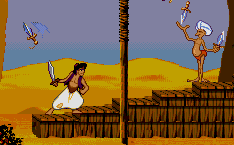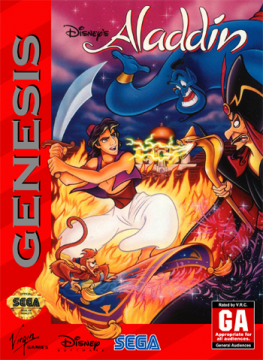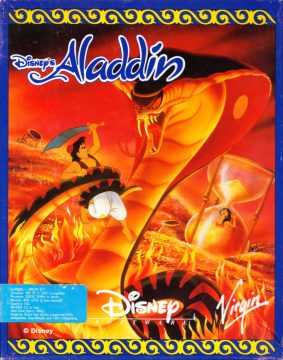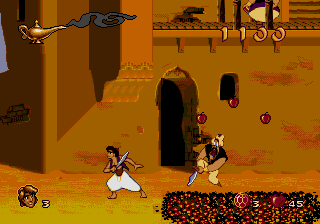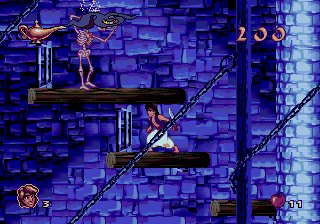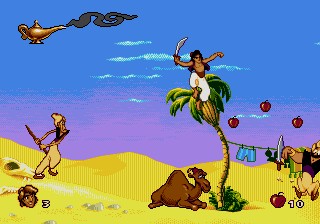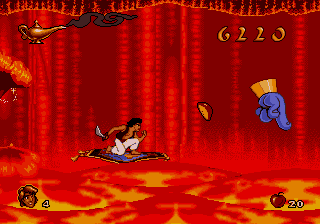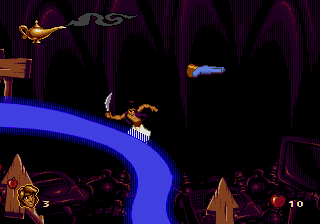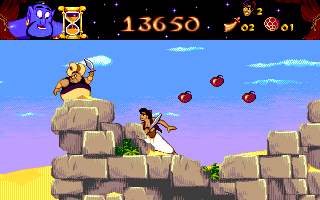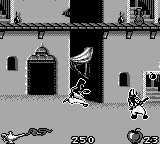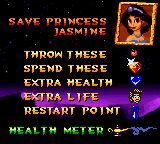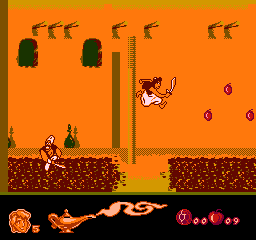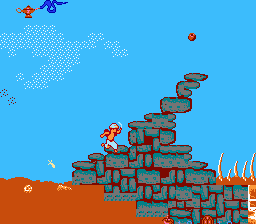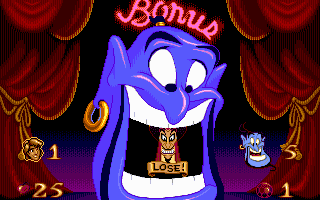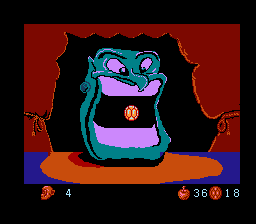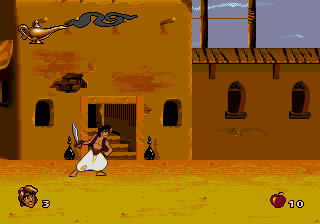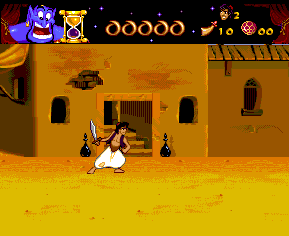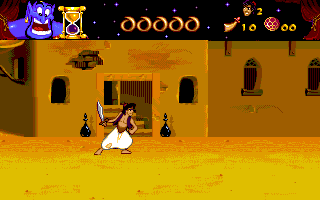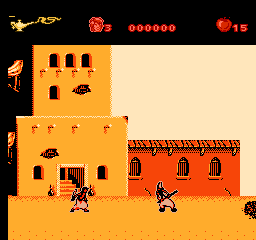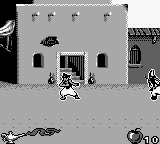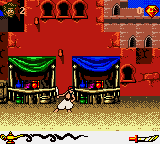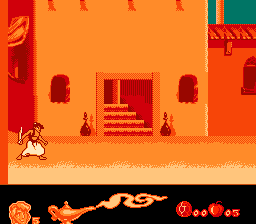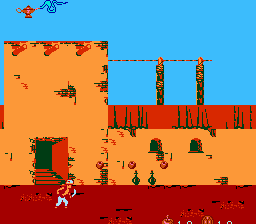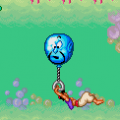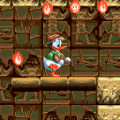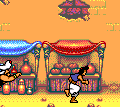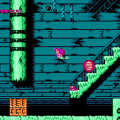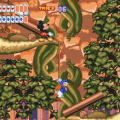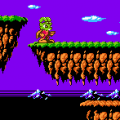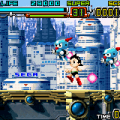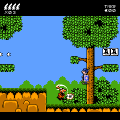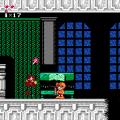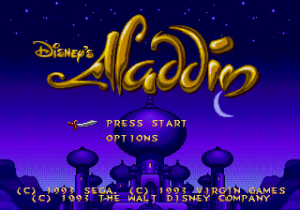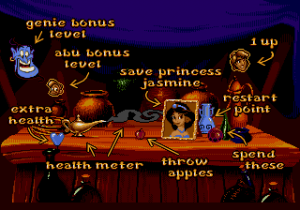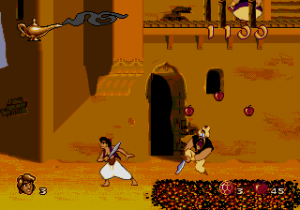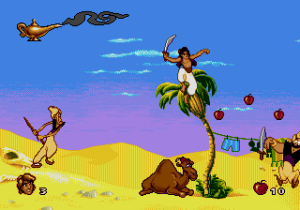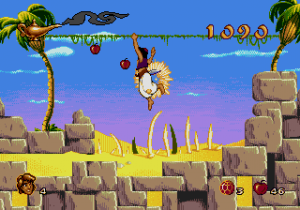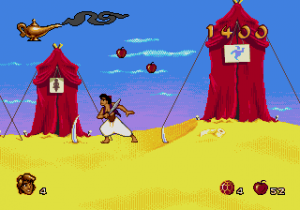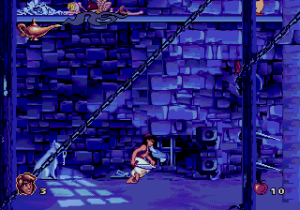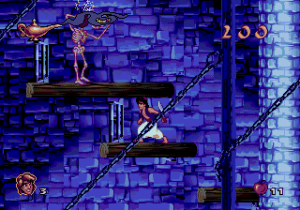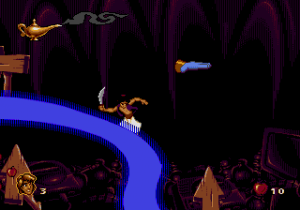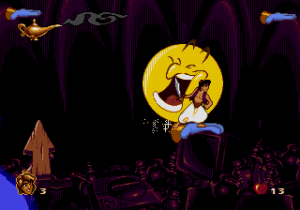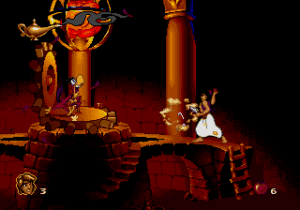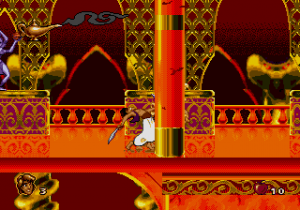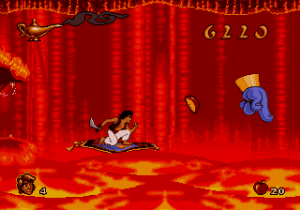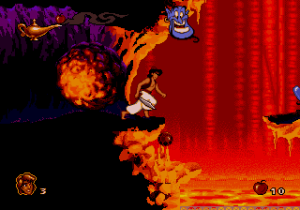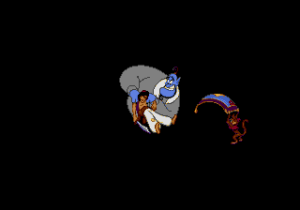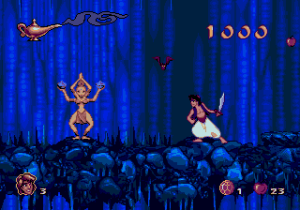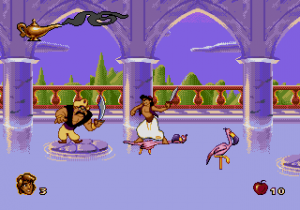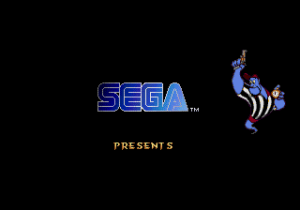- Aladdin (SNES)
- Aladdin (Sega / Virgin)
- Aladdin (SMS/GG)
While the SNES version of Aladdin was handled by Capcom, the Genesis version was programmed by Virgin Games, in collaboration with Sega and Disney Software. So of course, rather than being a port, it’s a completely different game. The game starts off similarly, in Agrabah market, but goes off in different directions after that. One of the main differences is that Aladdin is always armed with a sword here, whereas he needed to jump on enemies in the SNES game to kill them.
The Genesis’ version’s main draw is that the developers worked closely with members of Disney’s animation studios to create something that looked, sounded, and felt extraordinarily close to the source material. This included access to many of the original illustrations, allowing the designers at Virgin to replicate the style faithfully in the game. But more importantly involved a process called “Digicel” – much like “blast processing”, it’s a marketing buzzword, but refers specially to the method in which drawn cartoon cels are scanned into a computer and then touched up for use in a video game. Even though this was the first time this process was used, it produced remarkable results. Without shading, the characters use a fairly palette, which kept within the technical limitations of the Genesis’ 64 color on screen palette. Compare it to the SNES version, which technically uses more colors but looks more like….well, a Capcom SNES game than the Disney movie it was based on. In working with the animation producers at Virgin, the designers were able to capture several characters that only looked gorgeous, but were smoothly animated, all within the confines of a 16 megabit cartridge.
Beyond the style, the level of detail has a certain level of authenticity that transcends not only the SNES game but most licensed games in general. One particular type of enemy swordsman routinely loses his pants, a reference to a quick shot of a guardsman in the movie. In fact, many of the enemies are taken from various minor characters, including the knife throwers, as well as occasional appearances by Iago the parrot. The backgrounds contain fun little games, like tents that act as outhouses for men, women, and genies. Various skeletons have little Mickey Mouse ears on then. When you run out of health, you don’t technically “die”, but rather the Genie calls a time-out and gives Aladdin a rest and a shoulder rub before restarting the level. Not every gag is lifted from the movie either, but everything here keeps with the same tone, making it feel like a logical extension.
Most of the music is taken from the movie, primarily Alan Menken’s vocal songs. Surprisingly, these are all rendered excellently within the limits of the Genesis’ FM synth, despite missing the lyrics. There are a few original songs added in, primarily the fun “Camel Jazz” and the exciting “Arab Rock” themes provided by recurring Virgin composer Tommy Tallarico as well as Donald Griffin.
The game was programmed by David Perry, a programmer who had worked on a few other titles for Virgin, including Mick and Mack Global Gladiators and Cool Spot, and later went on to create Earthworm Jim. As a result, it feels very similar to those games. Before Virgin began work on the project, he was actually working on a Genesis version of The Jungle Book, but his engine was adapted for use with Aladdin. (This game was later finished by Virgin without Perry’s involvement, as by that point he had left to form Shiny.)
The main hallmark of a David Perry game is the large, sprawling levels, that scrolled multidirectionally rather than just being forced from left to right. His earlier titles had elements that required exploring the stages for collectibles, which is greatly scaled back for Aladdin (only one of the stages requires this). In spite of the more linear nature, Aladdin’s path still sends him zig-zagging through the levels, often with small branches that lead to bonus items. These include apples, which are collected and used as ammunition to throw at enemies; gems, to be used as currency to purchase stuff from shopkeepers, like extra lives or “wishes” (continues); Genie tokens, to allow you to play a slot bonus round; and Abu tokens, to unlock another special stage starring Abu the monkey, where you need to dodge falling pots. Stages occasionally have foreground elements that can hide items too, giving a more three dimensional texture to two dimensional levels. The levels include two areas that take place in the Agrabah Market, a trip through the desert, exploring the Cave of Wonder (and subsequent escape, including riding on the magic carpet as you fly from a wave of lava), a goofy area that takes place inside the Genie’s lamp, and then two stages in the palace, where you face off against Iago and Jafar.
However, the consistent downsides of Perry’s games is the prioritization of animation over control. Aladdin is animated beautifully, but the jumping is spongy, and never quite feels right. This is particularly true in the lamp level, where Aladdin can fall through various floors, and it’s tough to get a feel of what’s actually solid ground. Worse is the sword swinging, which has a strangely long wind-up animation. It’s extremely sluggish, and in the cases where you need to sword fight guards, it’s often a matter of just bashing the buttons and hoping you have enough life to survive. As a backup, the game is generous with apples, so you can always take a less direct approach to combat. Indeed, in some of the boss battles, attacking with a sword is extremely difficult, so the game just continually spawns apples to attack with. There are other quirks with the engine too, especially as the camera occasionally loses center on Aladdin and then needs to quickly jerk the view whenever he faces the opposite direction.
So of course, in the “SNES vs. Genesis” showdown, each succeed on different grounds. Purely as a platformer, the SNES game is a bit better, purely for the tighter controls. Capcom had honed their skills in the late 80s and early 90s, rarely putting out a stinker, and this was no different. But as a product, the Genesis game simply feels more authentic. Back before the days of expensive, cinematic AAA games, the goal of any 8- or 16-bit game was to present a version of the movie’s world you could play around in. The Genesis game isn’t entirely faithful, story-wise – most of it takes place within the movie’s first act, and after the Genie’s level, it simply zooms ahead to final confrontations with Jafar. But everything else about it feels like you’re in the game, which is arguably more important. There are tons of games out there like the SNES Aladdin. There are very few like the Genesis one, even the subsequent Disney platformers published by Virgin.
Although nothing was announced at the time, there were plans to port the Genesis game to the Sega CD. This would’ve included several new enemies and levels that were cut from the Genesis game, including stages where Aladdin is dressed as Prince Ali, as well as extra weapons and boss fights. It was canceled fairly early, both as Perry had left the company and the Sega CD was proving to be a failure, but some remnants, including some enemies, can be found in a prototype ROM that has found its way onto the Internet.
This version of Aladdin is most closely associated with the Sega Genesis, as it was hugely popular, being the third best-selling game on the system, behind the first two Sonic the Hedgehog games. But it was not platform agnostic, and was actually ported to several other platforms.
The game was released in Europe for both the Amiga and IBM PC. These are both fairly similar to each other, and both look and play similarly to the Genesis game, though the scrolling isn’t quite as smooth. The biggest change is the addition of a status bar at the top of the screen, which includes a few new elements, like the score. In the Genesis version, Aladdin’s health is indicated by the smoke coming out of the lamp; here, it’s indicated by the hourglass and Genie’s expression, who gets more panicked and dire as Aladdin takes damage. The downside of this is extra the screen real estate it takes up. The Amiga version runs at a similar resolution as the Genesis version, so it doesn’t crop off that much of the playing field. It’s much more annoying in the IBM PC version, which runs at a lower vertical resolution. The status bar is the same size though, so it proportionally eats up more screen real estate, which is a big problem in places like the Genie’s lamp, as you can’t always see what you’re supposed to be jumping towards. Otherwise, the graphics are converted well, and the multiplane scrolling is impressive for the Amiga. However, there are still details that are missing, like the lava wave that chases you during the magic carpet escape sequences.
Both versions also have controls and physics that are very slightly different from the Genesis version, the most noticeable being the lack of a super jump that originally allowed Aladdin to leap extra high and grab items normally out a reach. Without this, these items are extremely difficult if not impossible to obtain. The Amiga joystick only has two buttons, so you need to use some other method to switch between the apples and sword; meanwhile, the IBM PC version lets you map your controller, but a glitch will cause them to use the same button regardless of what you tell it to use.
Both versions feature music redone in the Amiga MOD format, which uses samples rather than the FM synth of the Genesis. It sounds weird when comparing the two, but on their own merits, it’s a pretty good rendition. It even adds some lyrics to the “A Whole New World” theme. However, the “Camel Jazz” theme was replaced with something different, and it’s missing several music change cues. For example, the music is supposed to stop when Aladdin runs out of health or plays the end-of-level slot machine, but they continue to play here. Altogether, these ports will definitely feel off to anyone who’s played the Genesis version, but for the market it was intended – families who owned computers but not game consoles – it’s close enough.
The Genesis version was also used as the basis for two ports to Nintendo’s portable console. The Game Boy version was developed by NMS Software, released in 1994 in North America, a year after Sega’s version. It tries to resize and recolor the assets from the Genesis game, but it doesn’t quite work. Again, it prioritizes animation over control, although here it’s much worse. Although the sprites are extremely smooth, the game is also staggeringly sluggish, running at a fraction of the speed it should. Aladdin is also completely uncontrollable during many frames, such as when he falls too far, and he can’t use his sword in mid-air either. It just feels bad to play. It’s also missing a few levels, including the Genie lamp stage and the battle with Iago. What’s more baffling is the music. Most of it is just generic tunes, except for “A Whole New World”, which is piped in at completely inappropriate times, including the final fight with Jafar. This version was used as the basis for the absolutely abysmal NES port, which was only released in Europe. They attempted to quickly convert the monochromatic visuals to the NES color palette, which results in almost everything on the screen being a few shades of the same color. It has all of the same issues as the portable version too, and feels even weirder with the tiny sprites on the larger sized screen. Due to the way it was programmed, it also won’t work on NTSC systems, though it’s not like anyone is missing much.
On the other hand, the Game Boy Color port, released six years later in 2000 and developed by Crawfish Interactive, is a substantial improvement. The designers didn’t just take the Game Boy game and add colors, they completely redrew and reprogrammed everything from scratch. The animation is quite as good, and obviously it doesn’t look nearly as good as the Genesis game, but it runs at a proper speed and generally plays pretty well. The soundtrack again consists (mostly) of chiptunes renditions of the movie music, which is pretty decent, although “Camel Jazz” is once again changed to a different song. It’s missing the same stages as the previous Game Boy port, but otherwise, it’s pretty decent considering the hardware.
In addition to the official NES version, there are also three bootleg releases of Aladdin. One is based off the SNES game, while the other two are based off of the Sega/Virgin one. The version developed by Super Game is actually surprisingly well done. The visuals look relatively solid, as if they were actually traced from the Genesis game, and while the controls aren’t perfect, they’re generally well implemented. Even the music is well converted. The downside is that it’s only four levels long – the first three (Agrabah Market, The Desert and Agrabah Rooftops) and then the Rug Ride stage. Still, even though it’s less than half of the game, it’s markedly better than the legit release. An altered version of the game using a different mapper was released as Super Aladdin, which includes some images nicked from the Genesis version of Prince of Persia.
Far less impressive is the one developed by Chengdu Tai Jing Da Dong and is commonly referred to as Aladdin II. Think of every stereotype of a bootlegged product, and you’ll find it here. The characters aren’t quite right (Aladdin wears a turban here) and most everything else appears to have been scribbled from vague memory. (Especially amusing is the horrific portrait of the Genie in the slot machine bonus game.)
The controls and physics are reprehensible, and the first level alone is incredibly difficult to complete because it feels like absolutely nothing works. There is a level select built-in where you can see the whole game, which includes nearly all of the stages, except for (as with the other ports) the Genie’s lamp level and the Iago boss fight. Anyway, this one actually is worse than the legit NES release, and is poor even by pirated game standards.
Sega also released a version of Aladdin for the Game Gear and Master System, though rather than basing it off of Virgin’s title, it’s a completely different game.
Screenshot Comparisons
Links:
Digging for treasure in Aladdin’s source code Includes some missing enemies and features
Sega-16: Behind the Design – Aladdin
